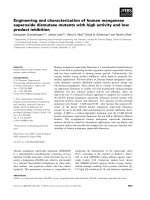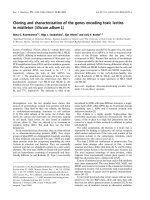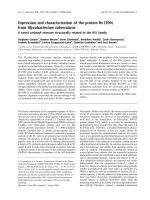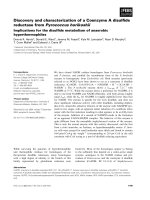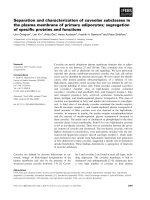Báo cáo khoa hoc:" Construction and characterization of a bovine BAC library with four genome-equivalent coverage" pptx
Bạn đang xem bản rút gọn của tài liệu. Xem và tải ngay bản đầy đủ của tài liệu tại đây (177.27 KB, 6 trang )
Genet. Sel. Evol. 33 (2001) 543–548 543
© INRA, EDP Sciences, 2001
Original article
Construction and characterization
of a bovine BAC library with four
genome-equivalent coverage
André E
GGEN
a, ∗
, Mathieu G
AUTIER
a
,
Alain B
ILLAUT
d
, Élisabeth P
ETIT
a
, Hélène H
AYES
a
,
Pascal L
AURENT
a
, Catherine U
RBAN
b
,
Martha P
FISTER
-G
ENSKOW
c
, Ken E
ILERTSEN
c
,
Michael D. B
ISHOP
c
a
Laboratoire de génétique biochimique et de cytogénétique,
Département de génétique animale, Institut national de la recherche agronomique,
78352 Jouy-en-Josas Cedex, France
b
Fondation Jean Dausset, Centre d’étude du polymorphisme humain,
27 rue Juliette Dodu, 75010 Paris, France
c
Infigen Inc, 1825 Infinity Drive, DeForest, WI 53532, USA
d
Molecular Engines Laboratories, 20 rue Bouvier, 75011 Paris, France
(Received 21 March 2001; accepted 16 May 2001)
Abstract – A bovine artificial chromosome (BAC) library of 105 984 clones has been construc-
ted in the vector pBeloBAC11 and organized in 3-dimension pools and high density membranes
for screening by PCR and hybridization. The average insert size, determined after analysis of
388 clones, was estimated at 120 kb corresponding to a four genome coverage. Given the fact
that a male was used to construct the library, the probability of finding any given autosomal
and X or Y locus is respectively 0.98 and 0.86. The library was screened for 164 microsatellite
markers and an average of 3.9 superpools was positive for each PCR system. None of the 50 or
so BAC clones analysed by FISH was chimeric. This BAC library increases the international
genome coverage for cattle to around 28 genome equivalents and extends the coverage of the
ruminant genomes available at the Inra resource center to 15 genome equivalents.
bovine / BAC library / mapping
1. INTRODUCTION
In cattle, numerous reports have identified genomic regions corresponding to
economically important traits [3,5, 7] based on low to medium density marker
maps. The density of these maps, however, is not sufficient to identify DNA
∗
Correspondence and reprints
E-mail:
544 A. Eggen et al.
variations responsible for genetic variation. Moreover, successful implement-
ation of Marker Assisted Selection (MAS) programs and the generation of
transgenic and knockout cattle will benefit from greater characterization of
the bovine genome. Identification of DNA variations using fine mapping and
positional cloning strategies, increasing the density of region-specific markers,
and continued characterization of the genome for the production of genetically
modified cattle requires the development of additional tools. A highly valuable
tool procedure has been developed to generate large genomic DNA inserts
with an acceptable genomic fidelity in a bacterial artificial chromosome (BAC)
library to obtain complete coverage of the genome.
In addition to increased clone fidelity and a low level of cloning artefacts,
BAC DNA can be more easily separated from the host’s DNA. Consequently,
BACs provide an excellent template for shotgun sequencing strategies and
have become the main sequence-ready clone ressources for use in large-scale
mapping and sequencing efforts. Individual clones often contain complete
genes embedded in their genomic environment. The clones can thus be used
for functional studies in cell lines or transgenic applications.
In this paper, we present the construction and extensive characterization
of another bovine BAC library [1,2,11,13] containing 105 984 clones with
an average size of 120 kb, which corresponds to about four genome equival-
ents. PCR-based screening and fluorescence in situ hybridisation (FISH) were
performed in order to estimate the quality of the library.
2. MATERIAL AND METHODS
2.1. DNA preparation
A cell line derived from the genital ridge of a male fœtus from a high ranking
holstein bull was used to prepare 100 µL DNA plugs embedded in low-melting
agarose (0.5%) in PBS at a concentration of about 2×10
6
cells per plug (10 µg).
The plugs were incubated twice in buffer containing proteinase K (1 mg · mL),
EDTA (0.5 M, pH 8.5) and N-Lauryl-Sarcosine (1%) at 55
◦
C for 24 h. After
inactivation of the proteinase K in PMSF (40 µg · mL) for 30 min, the plugs
were rinsed twice in Tris 10 mM, EDTA 1 mM (TE 10-1) for 30 min and stored
in EDTA (50 mM, pH 8.0) for up to 2 months at 4
◦
C.
2.2. BAC vector preparation
pBeloBAC11 was kindly provided by H. Shizuya, Department of Bio-
logy, California Institute of Technology (Pasadena, Calif.). Preparation of
pBeloBAC11 was carried out as described [12].
Construction of a bovine BAC library 545
2.3. Partial digestion with HindIII
Partial digestion was carried out on plugs, each containing approximately
10 µg of high-molecular-weight DNA, after three 1-h equilibration steps in
10 mL of 1X HindIII digestion buffer (Boehringer Mannheim, Germany). The
buffer was then removed and replaced by an ice-cold enzyme buffer (1 mL/plug)
containing 20 U of HindIII (Boehringer). After a 2 h incubation on ice, the
plugs were transferred to a 37
◦
C water bath for 20 min. Digestions were
stopped by adding 10 mL of glacial EDTA 0.25 M (pH 8).
2.4. Size selection
Partially digested DNA in the plugs was subjected to contour-clamped
homogeneous electric field (CHEF) electrophoresis on a 1% low-melting point
agarose gel, using a DR III apparatus (Biorad, Hercules, Calif.) in 1X Tris-
acetate-EDTA buffer at 12
◦
C, with a ramp from 5 to 15 s at 6 V/cm for 16 h.
Agarose slices corresponding to size ranges from 75 to 100 kb, 100 to 120 kb,
120 to 150 kb, 150 to 180 kb were excised from the gel and stored in TE at 4
◦
C.
2.5. Ligation and transformation
Agarose slices containing the fractions were melted at 65
◦
C for 10 min
and digested with Gelase (Epicentre Technologies, Madison, Wis.) using 1 U
per 100 mg of gel slice. Then 10 to 100 µg of each size selected DNA were
ligated in a molar ratio of 1:5 to 1:10 to HindIII- digested, dephosphorylated
pBeloBAC11, using 10 U of T4 DNA ligase (New England Biolabs, Beverly,
Mass) at 12
◦
C for 36 h. Ligation mixtures were heated at 65
◦
C for 15 min and
then drop-dialysed against 0.5X Tris-EDTA, using VS 0.025 µm membranes
(Millipore, Bedford, Mass.). Fresh electrocompetent E. Coli DH10B cells [9]
were harvested from 200 mL of mid-log phase cultures grown in SOB medium,
washed twice in ice-cold water with the same volume of culture and once in
50 mL. Finally, cells were resuspended in ice-cold water to an optical density
of 150 at 550 nm.
1–2 µL of ligation mix was used to transform 30 µL of electroporation
competent E. Coli DH10B cells in an Easyject Plus electroporator (Equibio
Kent, U.K.) with settings of 2.5 kV, 25 µF and 99 Ω, in 2-mm-wide elec-
troporation cuvettes. After electroporation, the cells were resuspended in
1 mL of SOC medium, allowed to recover for 45 min at 37
◦
C with gentle
shaking, and then plated on LB agar containing chloramphenicol (12.5 µg·mL),
5-bromo-4-chloro-3-indolyl-B-D-galactopyranoside (X-Gal, 50 µg · mL), and
isopropyl-β-D-thiogalactopyranoside (IPTG, 25 µg · mL). The plates were
incubated 20 h and recombinant white colonies were then manually picked in
MEGA 96-well microtiter plates, each well containing 1.2 mL LB with 10%
546 A. Eggen et al.
0
10
20
30
40
50
60
70
<20 20-
30
31-
40
41-
50
51-
60
61-
70
71-
80
81-
90
91-
100
101-
110
111-
120
121-
130
131-
140
141-
150
151-
160
161-
170
>171
Insert size in kb
Clones number
Figure 1. Distribution of insert sizes in the bovine BAC library for a total of 388
clones analysed.
glycerol (w:v) and 12.5 µg· mL chloramphenicol. After an 18–20 h incubation
at 37
◦
C with vigorous shaking, three copies of each 96-well microtitre plate
were prepared and stored at −80
◦
C at different locations. Superpools of 24
plates and pools of individual plates (24), 12 columns and 8 rows were prepared
by mixing respectively 300 µL and 3 times 120 µL of the bacteria culture. The
different pools were collected manually. For each pool, bacteria were then
pelleted, resuspended in TE, and the DNA was prepared by microwave boiling
as described [8].
3. RESULTS AND DISCUSSION
Forty-six superpools were prepared corresponding to 105 984 clones. The
average insert size was determined by field inversion gel electrophoresis(FIGE)
after digestion with NotI. A total of 388 clones was selected with insert sizes
ranging from 6–225 kb and a mean size of 120 kb (Fig. 1). Less than 2% of the
clones were considered as empty. Assuming that the bovine genome contains
3× 10
9
bp, the total library corresponds to four genome-equivalents. Therefore
the probability of finding any given autosomal locus in the library is 0.98 and
given the fact that a male was used to construct the library, the probability of
finding any given X or Y locus is 0.86.
The BAC library was screened by PCR with primers for 164 microsatellite
markers and genes and an average of 3.9 superpools were positive for each
PCR system. Only one microsatellite was not found in the library. The library
was also successfully screened for the 31 marker genes of the Texas standard
Construction of a bovine BAC library 547
nomenclature of the bovine karyotype [4], providing an accurate set of BAC
clones which were used to resolve chromosome identification problems [4,6].
Fluorescence in situ hybridisation was performed as described [6] for over 50
BAC clones: none of the clones was chimeric.
Recently, the entire BAC library was spotted on high density membranes
and transferred to 384 well-plates in order to permit screening of the library by
hybridisation, in addition to PCR screening.
The bovine BAC library described in this publication contributes to increas-
ing the genome coverage for cattle. Added to the already existing BAC libraries
of 2.7 [1], 6 [2], 10 [11] and 5 [13] genome equivalents, the total coverage of the
bovine genome represented in BAC libraries is around 28. Added to the bovine
YAC, ovine BAC [10] and goat BAC [8] libraries hosted at Inra, this gives a
15 genome-equivalent coverage of the ruminant genomes available through the
Inra resource center ( />ACKNOWLEDGEMENTS
We wish to thank François Piumi for his helpful contribution to the produc-
tion of high density membranes.
REFERENCES
[1] Buitkamp J., Kollers S., Durtewitz G., Fries R., Welzel K., Schäfer K., Keller-
mann K., Lehrach H., Construction and characterization of a gridded cattle BAC
library, Anim. Genet. 31 (2001) 347–351.
[2] Cai L., Taylor J.F., Wing R.A., Gallagher D.S., Woo S.S., Davis S.K., Con-
struction and characterization of a bovine bacterial artificial chromosome library,
Genomics 29 (1995) 413–425.
[3] Charlier C., Farnir F., Berzi P., Vanmanshoven P., Brouwers B., Vromans H.,
Georges M., Identity-by-descent mapping of recessive traits in livestock: applic-
ation to map the bovine syndactyly locus to chromosome 15, Genome Res. 6
(1996) 580–589.
[4] Gautier M., Laurent P., Hayes H., Eggen A., Development and assignment
of bovine specific PCR-system for the Texas nomenclature marker genes and
isolation of homologous BAC probes, Genet. Sel. Evol. 33 (2001) 191–200.
[5] Georges M., Andersson L., Livestock genomics comes of age, Genome Res. 6
(1996) 907–921.
[6] Hayes H., DiMeo G.P., Gautier M., Laurent P., Eggen A., Iannuzzi L., Local-
ization by FISH of the 31 Texas nomenclature type I markers to both Q and
R-banded bovine chromosomes, Cytogenet. Cell Genet. 90 (2000) 315–320.
[7] Riquet J., Coppieters W., Cambisano N., Arranz J.J., Berzi P., Davis S.K.,
Grisart B., Farnir F., Karim L., Mni M., Simon P., Taylor J.F., Vanmanshoven P.,
Wagenaar D., Womack J.E., Georges M., Fine-mapping of quantitative trait loci
548 A. Eggen et al.
by identity by descent in outbred populations: application to milk production in
dairy cattle, Proc. Natl. Acad. Sci., USA 96 (1999) 9252–9257.
[8] Schibler L., Vaiman D., Oustry A., Guinec N., Dangy-Caye A.L., Billault A.,
Cribiu E.P., Construction and extensive characterization of a goat bacterial arti-
ficial chromosome library with threefold genome coverage, Mamm. Genome 9
(1998) 119–124.
[9] Sheng Y., Mancino V., Birren B., Transformation of Escherichia coli with large
DNA molecules by electroporation, Nucl. Acids. Res. 23 (1995) 1990–1996.
[10] Vaiman D., Billault A., Tabet-Aoul K., Schibler L., Vilette D., Oustry-Vaiman A.,
Soravito C., Cribiu E.P., Construction and characterization of a sheep library of
three genome equivalents, Mamm. Genome 10 (1999) 585–587.
[11] Warren W., Smith T.P.L., Rexroad III C.E., Fahrenkrug S.C., Allison T., Shu C.L.,
Catanese J., De Jong P.J., Construction and characterization of a new bovine
bacterial artificial chromosome library with 10 genome-equivalent coverage,
Mamm. Genome 11 (2000) 662–663.
[12] Woo S.S., Jiang J., Gill B.S., Paterson A.H., Wing R.A., Construction and
characterization of a bacterial artificial chromosome library of Sorghum bicolor,
Nucl. Acids Res. 22 (1994) 4922–4931.
[13] Zhu B., Smith J.A., Tracey S.M., Konfortov B.A., Welzel K., Schalkwyk L.C.,
Lehrach H., Kollers S., Masabanda J., Buitkamp J., Fries R., Williams J.L.,
Miller J.R., A 5x genome coverage bovine BAC library: production, character-
ization, and distribution, Mamm. Genome 10 (1999) 706–709.
To access this journal on line:
www.edpsciences.org





